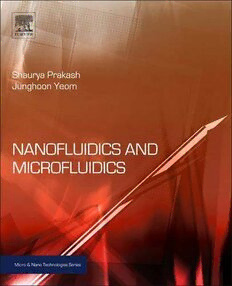Table Of ContentNanofluidics and
Microfluidics
This pageintentionallyleftblank
Nanofluidics and
Microfluidics
Systems and Applications
Shaurya Prakash and Junghoon Yeom
AMSTERDAM(cid:129)BOSTON(cid:129)HEIDELBERG(cid:129)LONDON
NEWYORK(cid:129)OXFORD(cid:129)PARIS(cid:129)SANDIEGO
SANFRANCISCO(cid:129)SINGAPORE(cid:129)SYDNEY(cid:129)TOKYO
WilliamAndrewisanimprintofElsevier
WilliamAndrewisanimprintofElsevier
225WymanStreet,Waltham,02451,USA
TheBoulevard,LangfordLane,Kidlington,OxfordOX51GB,UK
Firstedition2014
Copyrightr2014ElsevierInc.Allrightsreserved
Nopartofthispublicationmaybereproducedortransmittedinanyformorbyanymeans,
electronicormechanical,includingphotocopying,recording,oranyinformationstorage
andretrievalsystem,withoutpermissioninwritingfromthepublisher.Detailsonhowto
seekpermission,furtherinformationaboutthePublisher’spermissionspoliciesand
arrangementswithorganizationssuchastheCopyrightClearanceCenterandtheCopyright
LicensingAgency,canbefoundatourwebsite:www.elsevier.com/permissions.
Thisbookandtheindividualcontributionscontainedinitareprotectedundercopyrightby
thePublisher(otherthanasmaybenotedherein).
Notice
Knowledgeandbestpracticeinthisfieldareconstantlychanging.Asnewresearchand
experiencebroadenourunderstanding,changesinresearchmethods,professionalpractices,
ormedicaltreatmentmaybecomenecessary.
Practitionersandresearchersmustalwaysrelyontheirownexperienceandknowledgein
evaluatingandusinganyinformation,methods,compounds,orexperimentsdescribed
herein.Inusingsuchinformationormethodstheyshouldbemindfuloftheirownsafety
andthesafetyofothers,includingpartiesforwhomtheyhaveaprofessionalresponsibility.
Tothefullestextentofthelaw,neitherthePublishernortheauthors,contributors,or
editors,assumeanyliabilityforanyinjuryand/ordamagetopersonsorpropertyasa
matterofproductsliability,negligenceorotherwise,orfromanyuseoperationofany
methods,products,instructions,orideascontainedinthematerialherein.
LibraryofCongressCataloging-in-PublicationData
AcatalogrecordforthisbookisavailablefromtheLibraryofCongress
BritishLibraryCataloguinginPublicationData
AcataloguerecordforthisbookisavailablefromtheBritishLibrary
ISBN:978-1-4377-4469-9
ForinformationonallElsevierpublications
visitourwebsiteatelsevierdirect.com
PrintedandboundintheUSA
14 13 12 11 10 9 8 7 6 5 4 3 2 1
Contents
Preface......................................................................................................................ix
Aboutthe Authors....................................................................................................xi
Acknowledgments.................................................................................................xiii
Nomenclature List...................................................................................................xv
CHAPTER 1 Introduction..................................................................................1
1.1 Length scales.................................................................................1
1.2 Scope and layoutofthe book.......................................................6
1.3 Future outlook...............................................................................7
References.............................................................................................8
Select bibliography................................................................................8
CHAPTER 2 Fundamentals for Microscale and Nanoscale Flows....9
2.1 Introduction...................................................................................9
2.2 Definition ofa fluid....................................................................10
2.3 Pressure-driven flows..................................................................10
2.4 Low Reynolds number flows......................................................13
2.5 Electrokinetic phenomena...........................................................16
2.6 The electric doublelayer.............................................................17
2.7 Debye length................................................................................20
2.8 Electrokinetic phenomena:revisited...........................................26
2.9 Coupling species transport andfluid mechanics........................30
2.10 Numerical simulations and advanced modelingmethods........31
Exercises..............................................................................................34
References...........................................................................................35
Select bibliography..............................................................................35
CHAPTER 3 Interfaces in Microfluidic and Nanofluidic Systems...39
3.1 Introduction.................................................................................39
3.2 Introductionto surfaces...............................................................40
3.3 Surface charge.............................................................................41
3.4 Surface energy.............................................................................43
3.5 Thermodynamics ofsurfaces......................................................45
3.5.1 Formation ofsurface layers..............................................46
3.5.2 Surface modification methods..........................................55
3.6 Surface characterization methods with relevanceto
microfluidics and nanofluidics....................................................60
3.6.1 Indirect methods...............................................................60
3.6.2 Directmethods..................................................................67
3.7 Surface tension-driven flows.......................................................73
3.8 Device interfaces.........................................................................75
v
vi Contents
References...........................................................................................77
Select bibliography..............................................................................78
CHAPTER 4 Advanced Fabrication Methods and Techniques..........87
4.1 Introduction tomicro-and nanofabrication................................88
4.1.1 Patterning—photolithography...........................................88
4.1.2 Additive techniques........................................................100
4.1.3 Subtractive techniques....................................................112
4.1.4 Lift-off.............................................................................123
4.1.5 Bonding...........................................................................124
4.2 Advanced patterning techniques...............................................130
4.2.1 Remarks onnanoscale patterning...................................130
4.2.2 Electron beam lithography..............................................132
4.2.3 Focusedion-beam lithography.......................................133
4.2.4 Nanoimprint lithography.................................................134
4.2.5 Soft lithography..............................................................136
4.2.6 Self-assemblyand self-organization...............................142
4.2.7 Other emergingtechniques.............................................148
4.3 Materialsin micro- andnanofluidics........................................150
4.3.1 Silicon.............................................................................151
4.3.2 Glass and quartz..............................................................154
4.3.3 Other ceramics................................................................155
4.3.4 Polymers..........................................................................156
4.3.5 Nanomaterials.................................................................157
4.4 Fabricationcase study...............................................................157
4.4.1 Case 1. Fabricationofgas microvalve andmicropump157
4.4.2 Case 2. Fabricationofsingle nanopore..........................159
References.........................................................................................162
Select bibliography............................................................................170
CHAPTER 5 Lab-on-a-Chip and Fluid Manipulation Applications.171
5.1 Introduction...............................................................................171
5.2 Fluid manipulation....................................................................172
5.3 Microvalves and nanovalves.....................................................173
5.4 Micropumps and nanopumps....................................................182
5.5 On-chipseparations and combinations.....................................186
5.5.1 Sample injection and separation.....................................187
5.6 Transport andanalysis systems for DNA.................................194
5.7 Biosensors..................................................................................197
5.8 Nanomedicine and nanobiotechnology.....................................205
5.9 Instrumentation andplatforms at the microscale
and nanoscale............................................................................206
Contents vii
5.9.1 Micro-gas chromatography: a case study for
a lab-on-a-chip system....................................................206
5.9.2 Micro-scale impedance measurements for flow
diagnostics at the nanoscale: acase study.....................214
References.........................................................................................219
Select bibliography............................................................................230
CHAPTER 6 Energy and Environmental Applications........................241
6.1 Introduction...............................................................................241
6.2 Combustion-based devices........................................................241
6.3 Microfuel cells...........................................................................244
6.3.1 Laminar flow-based fuel cells........................................246
6.3.2 Inorganic(cid:1)organic hybrid proton exchange
membrane based on porous silicon................................248
6.3.3 Onboard hydrogen generators for microfuel cells.........250
6.4 Electrokinetic energy conversion..............................................252
6.5 Sensors for water contamination...............................................254
6.6 Energy-efficient water purification...........................................254
6.6.1 Microfluidic and nanofluidic concentration
polarization for desalination...........................................257
6.6.2 Advanced membranes.....................................................258
6.6.3 Microbial desalination cells............................................259
6.7 Asymmetry-driven ionpumps...................................................261
References.........................................................................................261
Select bibliography............................................................................264
Appendix A: Review ofMathematical Concepts.................................................271
Appendix B: Useful TabulatedData.....................................................................283
Index......................................................................................................................287
This pageintentionallyleftblank
Preface
Microfluidics and nanofluidics span a broad array of disciplines including
mechanical, materials, and electrical engineering, surface science, chemistry,
physics, and biology. The interplay of all these disciplines has led to several
topics being covered by this multidisciplinary area and has consequently led to
several different types of devices and systems for myriad applications. Our intent
in writing this book is to present a comprehensive resource that integrates essen-
tials of microfluidic and nanofluidic systems in a single text. Therefore, the goal
is to present the underlying theory, discuss the main (and a large variety of) fabri-
cation methods that are commonly used and finally present a snapshot of the vari-
ety of applications. Throughout the book several case studies are presented to
highlight the development of systems and subsequent use in applications.
Therefore, the rationale behind the book is to demonstrate the use of multiple
disciplines and topics for constructing a broad array of systems for solving sci-
ence, engineering, andtechnology challenges.
The microfluidics and nanofluidics community comprises a growing group of
active, creative, and pioneering researchers. Therefore, this area has seen tremen-
dous growth inthe pastdecade evidencedby the large number ofscientific papers
and books that have been published. Our book presents a unique look at this vast
body of scientific literature from a systems perspective with the underlying
assumption that fundamental theories and fabrication go hand in hand for con-
structionandoperationofmanypractical devices. Therefore,itwouldbeuseful to
view the advances through the prism of “global” advances in science and technol-
ogy using our case studies as an example rather than advances in individual disci-
plines. The direct consequence of our approach is that this book covers a large
rangeoftopics.Itislikelythatwehaveomittedsomematerialeitherforclarityor
lack ofspace butwe assist the interestedreader by pointing them to aselect bibli-
ography at the end of each chapter. Finally, we expect the book to be adopted in
introductory courses on microfluidics and nanofluidics as it covers all the essen-
tials. Therefore, some chapters present exercises in the text with additional pro-
blems available on the companion website. In addition, the companion website
(which includes all chapters in digital form) presents a unique advancement in
sharing knowledge through books. We present a purely digital chapter that dis-
cusses several experimental methods relevant to microfluidics and nanofluidics.
The goal of this e-chapter is to demonstrate a variety of laboratory scale techni-
ques that are usually lost in the print format. Therefore, our book presents a first
comprehensive effort at viewing the discipline of microfluidics and nanofluidics
from an application standpoint driven by a systems approach by drawing upon
underlyingtheoriesandadvancesinfabrication.
Shaurya Prakash and JunghoonYeom
ix

